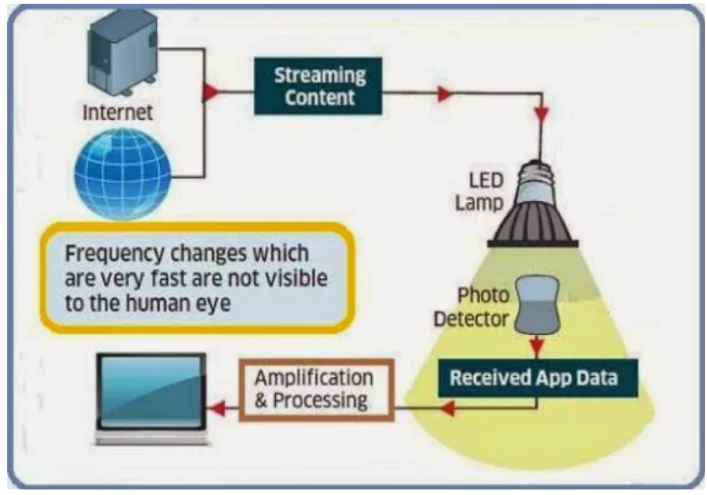Velmenni’s Li-Fi technology

|
- Recently, the Defence Ministry has implemented Velmenni’s Li-Fi technology to address communication challenges within the Indian Navy.
Velmenni’s Li-Fi technology
- About: Li-Fi, developed by Velmenni, utilizes light for secure wireless communication, supported through funding under India’s iDEX initiative.
Li-Fi technology:
- About: LiFi (Light Fidelity) is a wireless communication technology that utilizes visible light, particularly LED bulbs, for data transmission.
- Features: Invented by Professor Harald Haas in 2011, LiFi provides high-speed, bidirectional mobile communication similar to WiFi, offering faster speeds, reduced latency, and increased bandwidth (thousands of terahertz).
- Working:
- Data Transmission: Li-Fi utilizes LEDs, commonly used for lighting, to transmit information. These LEDs can be rapidly modulated to encode data. When an electrical signal is sent to an LED, it emits light. By varying the intensity of this light rapidly, information can be transmitted.
- Photodetectors as Receivers: Devices equipped with photodetectors, such as smartphones, laptops, or IoT devices, receive these modulated light signals.
- The photodetectors convert the received light into electrical signals, which are then processed as data.
|
Sampoornata Abhiyan

|
Sampoornata Abhiyan:
- About: It is a three-month initiative aimed at achieving full coverage of six key indicators in Aspirational Districts and six key indicators in Aspirational Blocks.
- Metrics:
-
- Key Indicators: Key indicators in aspirational districts include metrics such as the distribution of Soil Health Cards, availability of functional electricity in secondary schools, and the percentage of fully immunized children, among others.
- Key indicators in aspirational blocks include metrics such as the percentage of individuals screened for diabetes and hypertension, and the percentage of Self-Help Groups (SHGs) that have received a Revolving Fund, among others.
Aspirational Districts Programme:
- Introduction: Introduced in 2018 by NITI Aayog.
- Aim: It Aims to rapidly and effectively transform 112 districts nationwide.
- Focus areas: It focuses on five areas: Health & Nutrition, Education, Agriculture & Water Resources, Financial Inclusion & Skill Development Infrastructure
- Assessing Progress: Progress is assessed using 81 development indicators.
Aspirational Blocks Programme:
- Introduction: Introduced by NITI Aayog in 2023.
- Aim: It aims to achieve full coverage of essential government services in 500 blocks (329 districts) nationwide.
- Focus areas: It focuses on five key areas: Health & Nutrition, Education, Agriculture and Allied Services, Basic Infrastructure, Social Development
- Assessment: Progress is assessed using 40 development indicators.
|
American Declaration of Independence
|
- July 4 marks the 248th anniversary of the United States’ Independence Day, honoring the signing of the Declaration of Independence.
Formulation of the Declaration of Independence:
- Adoption and Signing: On July 4, 1776, the Continental Congress formally adopted the Declaration of Independence, signed by 56 delegates representing the thirteen colonies, signifying their decisive break from British rule.
- Foundation of Equality and Rights: The Declaration’s affirmation of equality and rights established the bedrock for American democratic ideals and independence, profoundly influencing the trajectory of American history and inspiring analogous movements globally.
|
Exercise Nomadic Elephant

|
- The 16th edition of the India-Mongolia Joint Military Exercise NOMADIC ELEPHANT began at the Foreign Training Node in Umroi, Meghalaya.
Exercise Nomadic Elephant:
- Aim: To strengthen the combined military capabilities of both nations for conducting counter-insurgency operations in a sub-conventional setting under Chapter VII of the United Nations Mandate. It will emphasize operations in semi-urban and mountainous terrain.
|
![]() 5 Jul 2024
5 Jul 2024
